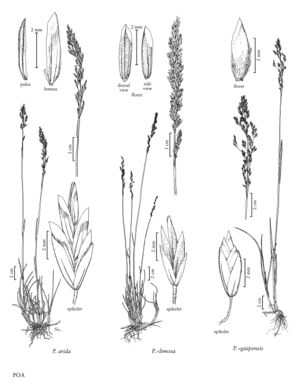Poa arida
Plants perennial; glaucous or not; densely to loosely tufted or the culms solitary, rhizomatous. Basal branching intra and extravaginal. Culms 15-80 cm, erect or the bases decumbent, terete or weakly compressed; nodes terete, 0-1 exserted. Sheaths closed for 1/10 – 1/5 (1/4) their length, terete, smooth or sparsely scabrous, glabrous, bases of basal sheaths glabrous, distal sheath lengths (1.2) 1.5-9 (20) times blade lengths; ligules (1) 1.5-4 (5) mm, smooth or sparsely to moderately scabrous, apices obtuse to acute; blades strongly to gradually reduced in length distally, 1.5-5 mm wide, flat and moderately thin to folded and moderately thick and firm, abaxial surfaces smooth, adaxial surfaces smooth or sparsely to moderately scabrous, primarily over the veins, apices narrowly prow-shaped, flag leaf-blades (0.4) 1-7 (10) cm. Panicles (2.5) 4-12 (18) cm, erect, usually narrowly lanceoloid, contracted, sometimes interrupted, infrequently loosely contracted, usually congested, with 25-100 spikelets; nodes with 1-5 branches; branches 1-9 cm, erect to infrequently ascending, rarely spreading, terete to weakly angled, smooth or the angles sparsely to moderately scabrous, with 3-24 spikelets. Spikelets 3.2-7 mm, lengths to 3.5 (3.8) times widths, laterally compressed; florets 2-7; rachilla internodes smooth, sometimes sparsely puberulent. Glumes lanceolate, distinctly keeled, smooth or sparsely scabrous; lower glumes 3-veined; calluses usually glabrous, infrequently webbed, hairs to 1/4 the lemma length; lemmas 2.5-4.5 mm, lanceolate to narrowly lanceolate, distinctly to weakly keeled, keels and marginal veins short to long-villous, lateral-veins moderately prominent, glabrous or puberulent, intercostal regions usually glabrous, infrequently hairy, hairs to 0.3 mm, margins glabrous, apices acute or blunt; palea keels scabrous, glabrous or short-villous at midlength, intercostal regions usually glabrous, sometimes puberulent to short-villous; anthers 1.3-2.2 mm. 2n = 56, 56+1, 56-58, 63, 64, 70, 76, 84, ca. 90, 95+-5, 100, 103.
Distribution
Ill., Ind., N.J., Colo., N.Mex., Tex., Ohio, Minn., Mich., Kans., N.Dak., Nebr., Okla., S.Dak., Mont., Alta., Man., Ont., Que., Sask., Iowa, Wyo.
Discussion
Poa arida grows mainly on the eastern slope of the Rocky Mountains and in the northern Great Plains, primarily in riparian habitats of varying salinity or alkalinity. It is spreading eastward along heavily salted highway corridors. Reports of its occurrence west of the Continental Divide and in southwestern Texas are mostly attributable to misidentifications of P. arctica subsp. aperta (p. 530). P. arctica subsp. grayana (p. 532), and rhizomatous specimens of P. fendleriana (p. 556).
Poa arida may reflect past hybridization between P. secunda (p. 586) and a species of Poa sect. Poa. Poa glaucifolia Scribn. & T.A. Williams refers to specimens of the northern Great Plains that have a more lax growth form with broader leaves and occasionally somewhat open panicles, florets with a small web, and sometimes lacking hairs between the keel and marginal veins of the lemma. Plants with these characteristics have chromosome counts of 2ra = 56 and 70, whereas P. arida sensu stricto usually has 2n = 63, 64, or greater than 70. It is suspected that some of the variability reflects introgression from P. secunda.
Poa arida is a named intersectional hybrid
Selected References
None.
Lower Taxa
"reduced" is not a number.No values specified."decumbent" is not a number.
